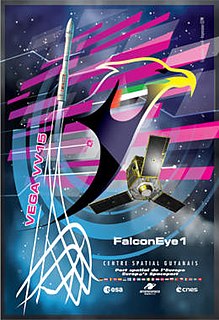
Ariane 5 is a European heavy-lift space launch vehicle developed and operated by Arianespace for the European Space Agency (ESA). It is launched from the Centre Spatial Guyanais in French Guiana. It has been used to deliver payloads into geostationary transfer orbit (GTO) or low Earth orbit (LEO). A direct successor system, Ariane 6, is in development.

Vega, is an expendable launch system in use by Arianespace jointly developed by the Italian Space Agency (ASI) and the European Space Agency (ESA). Development began in 1998 and the first launch took place from the Centre Spatial Guyanais on 13 February 2012.
Fregat (Russian: Фрегат, frigate) is an upper stage developed by NPO Lavochkin in the 1990s, which is used in some Soyuz and Zenit rockets, but is universal and can be used as a part of a medium and heavy class launch vehicles. Fregat became operational in February 2000. Its liquid propellant engine uses UDMH and N2O4. Fregat's success rate is 97,6% (with only 2 failures in 83 launches), which makes it one of the most reliable upper stages in the world. Fregat has been successfully delivered more than 300 payloads into different orbits. It remains the only upper stage in the world that can place its payload into 3 or more different orbits in a single launch.
SEOSat-Ingenio, was a Spanish project to produce a satellite capable of providing wide-field imagery ensuring a repeat cycle of 38 days at 2.5 metre panchromatic resolution and 10 metre colour resolution, from a sun-synchronous polar orbit; it was Spain's first optical imaging satellite. The satellite was part of the Spanish Earth Observation Satellite program. The mission was funded by Spain's Centre for the Development of Industrial Technology (CDTI). SEOSat-Ingenio information was to be used by various Spanish civil, institutional or government users. However, under the Copernicus Programme of the European Union, it was also accessible to other European users, as well as to the Group on Earth observation of the Global Observing System of Earth.

Soyuz at the Guiana Space Centre is an ongoing European Space Agency (ESA) programme for operating Soyuz-ST launch vehicles from Centre Spatial Guyanais (CSG), providing medium-size launch capability for Arianespace to accompany the light Vega and heavy-lift Ariane 5. The Soyuz vehicle is supplied by the Roscosmos with TsSKB-Progress and NPO Lavochkin, while additional components are supplied by Airbus, Thales Group and RUAG.
TARANIS was a observation satellite of the French Space Agency (CNES) which would have studied the transient events produced in the Earth's atmospheric layer between 10 km (6.2 mi) and 100 km (62 mi) altitude. TARANIS was launched in November 2020 with SEOSat-Ingenio aboard Vega flight VV17 and would have been placed in a sun-synchronous orbit at an altitude of 676 km, for a mission duration of two to four years, but the rocket has failed shortly after launch.

Ariane flight VA241 was an Ariane 5 space launch that occurred from the Guiana Space Centre on 25 January 2018 at 22:20 UTC.

Vega flight VV02 was the second flight of the Vega launcher. It occurred from the Guiana Space Centre on 7 May 2013 at 02:06:31 UTC.

Vega flight VV03 is the third flight of the Vega launcher. It occurred from the Guiana Space Centre on 30 April 2014 at 01:35:15 UTC.

Vega flight VV06 is the Vega space launch of the LISA Pathfinder satellite.

Vega flight VV07 is the 7th Vega space launch, of the PerúSAT-1 and 4 SkySat satellites.

Vega flight VV15 was the 15th flight of the Vega launcher, and its first failure.

Vega flight VV08 was the launch of Göktürk-1 on board the 8th flight of the Vega launcher.

Vega flight VV09 was the launch of the Sentinel-2B satellite by the 9th Vega launcher.

Vega flight VV10 was the launch of the OPTSAT-3000 & Venµs satellites by the 10th Vega launcher.

Vega flight VV11 was the launch of the Mohammed VI-A satellite by the 11th Vega launcher.

Vega flight VV12 was the launch of the ADM-Aeolus satellite by the 12th Vega launcher.

Vega flight VV13 was the launch of the Mohammed VI-B satellite by the 13th Vega launcher.

Vega flight VV14 was the launch of the PRISMA satellite by the 14th Vega launcher.

Vega flight VV16, also called SSMS PoC Flight, was the 16th launch of the Vega rocket. The launch was also notable as it was the first Vega launch following the accident of the VV15 launch in July 2019 that caused the loss of FalconEye1 satellite.


















